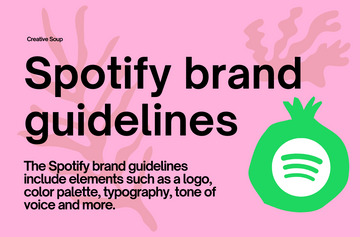In today's highly competitive business landscape, establishing a strong and recognizable brand identity is essential for success. A brand style guide serves as a crucial tool in achieving this objective. It provides a comprehensive set of guidelines and specifications that ensure consistency and coherence across all brand communications. In this article, we will explore the purpose and significance of a brand style guide in detail, highlighting its role in shaping brand identity, maintaining consistency, facilitating communication, and enhancing user experience.
I. Introduction
A. Definition of a brand style guide

A brand style guide, also known as a brand identity guide or brand book, is a document that outlines the visual and verbal elements that define a brand's identity. It serves as a reference manual for anyone involved in creating content or representing the brand, both internally and externally. The style guide provides guidelines and rules regarding the usage of branding elements such as logos, colors, typography, imagery, and writing style.
B. Importance of a brand style guide
A brand style guide plays a pivotal role in establishing a cohesive and recognizable brand identity. It ensures that all brand communications consistently reflect the brand's values, personality, and visual aesthetics. By providing clear instructions and examples, the style guide helps maintain consistency across various platforms, channels, and media, regardless of the individuals involved in creating the content. It serves as a reference point to align all brand touchpoints, building trust, recognition, and brand loyalty among the target audience.
II. Establishing Brand Identity

A strong brand identity is the foundation of successful branding. It distinguishes a brand from its competitors and creates a lasting impression in the minds of consumers. A brand style guide plays a crucial role in shaping and maintaining this identity.
A. Defining brand identity
Brand identity encompasses the unique characteristics, values, and attributes that differentiate a brand from others. It includes elements such as the brand's mission, vision, personality, and target audience. The style guide ensures that these defining elements are effectively communicated through consistent visual and verbal representations.
B. Consistency in brand representation
Consistency is key when it comes to building a strong brand. A brand style guide provides explicit guidelines on how the brand should be visually represented, including the logo and its variations, color palette and usage, typography and fonts, imagery, and overall visual assets. It ensures that these elements are consistently applied across all brand materials, whether it's a website, social media posts, advertising campaigns, or packaging design.
C. Building trust and recognition
A brand that maintains a consistent and coherent identity is more likely to earn the trust and recognition of its target audience. By adhering to the guidelines set forth in the brand style guide, businesses can establish a sense of reliability and professionalism. Consistent branding builds familiarity and helps consumers easily recognize and connect with the brand, even in a crowded marketplace.
III. Branding Elements

A brand style guide covers various visual and verbal elements that collectively contribute to a brand's identity. Let's explore these key elements in detail:
A. Logo and variations
The logo is the visual representation of a brand and is often the most recognizable aspect of its identity. The brand style guide specifies guidelines for logo usage, including size, placement, clear space, and acceptable variations such as horizontal or vertical orientations. It ensures that the logo is applied consistently across different mediums and maintains its integrity.
B. Color palette and usage
Colors evoke emotions and play a crucial role in brand recognition. The style guide defines the brand's primary and secondary color palette and provides guidance on their usage. It outlines color codes, color combinations, and specifies how colors should be applied to different brand assets. Consistent use of colors enhances brand recognition and reinforces the brand's visual identity.
C. Typography and fonts
Typography contributes to the overall visual appeal and personality of a brand. The style guide defines the primary and secondary fonts to be used in various contexts, such as headings, body text, and captions. It provides guidelines on font sizes, spacing, and formatting to ensure consistency and readability across different platforms and media.
D. Imagery and visual assets
Visual assets, such as photographs, illustrations, and graphics, contribute to a brand's visual identity. The style guide outlines the preferred style, mood, and quality of imagery that aligns with the brand's personality and target audience. It may provide examples of approved image styles and specify guidelines for image composition, filters, and image sources to maintain consistency.
E. Tone of voice and language
The style guide extends beyond visual elements and encompasses the brand's tone of voice and language. It defines the preferred writing style, whether it's formal, informal, conversational, or technical. It establishes guidelines for grammar, punctuation, and language usage, ensuring that the brand's communication is consistent, engaging, and aligns with its desired brand image.
IV. Maintaining Consistency

Consistency is a fundamental aspect of effective branding. A brand style guide serves as a comprehensive resource to maintain consistency across all brand touchpoints.
A. Ensuring consistent brand messaging
Consistent brand messaging is crucial to reinforce the brand's values, mission, and unique selling proposition. The style guide provides guidelines on the brand's key messages, taglines, and elevator pitches. It ensures that these messages are consistently communicated across different marketing channels, customer interactions, and brand campaigns.
B. Streamlining visual identity
The style guide acts as a visual compass, guiding the consistent application of branding elements across various platforms. It provides specifications on logo usage, color combinations, typography, and imagery, ensuring that the visual identity remains intact across websites, social media platforms, print materials, and any other brand touchpoints.
C. Coherence across different platforms and channels
In today's digital landscape, brands interact with their audience across multiple platforms and channels. The style guide ensures coherence and consistency in brand representation, whether it's a website, social media platform, email marketing, or offline advertising. It provides guidelines for adapting the brand's visual and verbal elements to suit different platforms while maintaining a cohesive brand identity.
V. Brand Guidelines

A brand style guide serves as a comprehensive document that outlines specific brand guidelines and rules. These guidelines ensure that the brand's identity is consistently represented across all communication channels and touchpoints.
A. Documenting brand rules and specifications
The style guide documents the rules and specifications that govern the usage of branding elements. It provides clear instructions on the acceptable and unacceptable ways to use the logo, colors, typography, imagery, and other visual assets. These guidelines ensure that anyone involved in creating brand content understands how to properly represent the brand visually and verbally.
B. Usage guidelines for logo, colors, typography, and imagery
The style guide provides detailed usage guidelines for each branding element. It specifies the different variations of the logo and when and where each variation should be used. It outlines the correct color codes, color combinations, and how to use colors in different contexts. Additionally, it provides instructions on font choices, font sizes, and how to maintain consistent typography. Moreover, it guides the selection and use of imagery to ensure that it aligns with the brand's visual identity.
C. Writing style and tone guidelines
In addition to visual elements, the style guide includes guidelines for written content. It establishes the brand's preferred writing style, whether it's friendly and conversational or professional and formal. It outlines guidelines for grammar, punctuation, and language usage to ensure consistency in written communication. These guidelines help maintain a unified voice and tone across all brand materials.
VI. Streamlining Communication
A brand style guide plays a vital role in streamlining communication, both internally and externally.
A. Internal communication
Within an organization, the style guide serves as a reference for employees involved in creating brand materials. It ensures that everyone understands and adheres to the brand's visual and verbal guidelines, maintaining consistency in all internal communications. The style guide acts as a tool for collaboration, allowing team members to work cohesively and produce cohesive brand assets.
B. External communication
Externally, the style guide serves as a reference for partners, vendors, and other stakeholders who collaborate with the brand. It provides clear instructions on how to represent the brand in their own communications and materials. By sharing the style guide, a brand can ensure that its external partners align with its identity and present a consistent image to the public.
C. Collaboration with partners and stakeholders
When collaborating with external agencies, designers, or content creators, the style guide becomes a valuable resource. It allows for effective collaboration by providing specific guidelines on branding elements, ensuring that the brand's identity is accurately represented in the collaborative work. This collaboration helps maintain consistency and coherence in brand messaging and visuals across different channels and platforms.
VII. Facilitating Brand Expansion
As brands grow and expand, the style guide becomes even more critical in maintaining brand integrity.
A. Scaling the brand consistently
When expanding into new markets or launching new product lines, a brand style guide ensures consistent branding across all touchpoints. It provides guidelines for adapting the brand's visual and verbal elements to suit different cultural contexts or target markets, while still preserving the core brand identity. This consistency helps customers recognize and trust the brand, even in new environments.
B. Ensuring brand recognition in new markets
A style guide facilitates brand recognition by ensuring that the brand's visual and verbal elements remain consistent across different markets. It guides the adaptation of branding elements to suit local preferences or cultural nuances while maintaining the overall brand identity. By consistently presenting a recognizable brand image, even in new markets, a brand can establish a strong presence and gain the trust of new customers.
C. Maintaining brand integrity across diverse channels
With the proliferation of digital channels and media, brands interact with their audience through various platforms. The style guide helps maintain brand integrity by providing guidelines for adapting the brand's visual and verbal elements to suit different channels. It ensures that the brand's identity remains consistent, regardless of whether it's a website, social media platform, mobile app, or any other digital or offline channel.
VIII. Enhancing User Experience
A well-executed brand style guide contributes to a positive user experience by creating a cohesive and engaging brand presence.
A. Creating a cohesive brand experience
Consistency in branding elements, such as logos, colors, typography, and imagery, creates a cohesive brand experience for users. When users encounter consistent branding across different touchpoints, they feel a sense of familiarity and trust, enhancing their overall experience with the brand.
B. Consistency in visual and verbal cues
By maintaining consistent visual and verbal cues, a brand style guide ensures that users can easily recognize and connect with the brand. Whether it's the logo, color scheme, or tone of voice, consistent branding provides users with a clear and cohesive brand identity, making it easier for them to engage with the brand and understand its value proposition.
C. Building brand loyalty and engagement
Consistency in branding fosters brand loyalty and encourages ongoing engagement from users. When users have positive and consistent experiences with a brand, they are more likely to develop a sense of loyalty and trust. This loyalty translates into repeat business, positive word-of-mouth, and increased engagement with the brand's content and offerings.
IX. Flexibility and Adaptability
While maintaining consistency is crucial, a brand style guide also allows for flexibility and adaptability to meet evolving needs.
A. Evolving with market trends
The style guide can be updated to accommodate changes in market trends and design aesthetics. As design trends evolve, the style guide can be revised to ensure that the brand remains relevant and visually appealing. By staying up-to-date with design trends, a brand can continue to resonate with its target audience.
B. Adapting to different platforms and media
The style guide should provide guidelines for adapting branding elements to suit different platforms and media. It ensures that the brand's visual identity translates effectively across various mediums, whether it's a website, social media platform, print advertisement, or video content. Adapting to different platforms while maintaining brand consistency allows the brand to reach a wider audience and maximize its impact.
C. Balancing consistency and innovation
While consistency is important, the style guide should also allow room for innovation and creativity. It should provide guidelines that encourage new ideas and experimental approaches within the boundaries of the brand's identity. This balance between consistency and innovation allows the brand to stay relevant and engaging while still maintaining a recognizable brand image.
X. Conclusion
A brand style guide is a powerful tool that shapes and maintains a brand's identity. It ensures consistency, coherence, and recognition across all brand touchpoints. By defining guidelines for branding elements, maintaining consistency in communication, facilitating collaboration, and enhancing user experience, a brand style guide becomes an invaluable resource in building a strong and successful brand.
FAQs (Frequently Asked Questions)
-
What happens if a brand doesn't have a style guide? Without a style guide, a brand risks inconsistent representation, which can confuse and alienate its audience. Inconsistencies in visual elements, messaging, and tone can dilute the brand's identity and weaken its recognition and recall.
-
Who should be involved in creating a brand style guide? Ideally, a brand style guide should be developed collaboratively, involving key stakeholders, marketing teams, designers, and content creators. Their diverse perspectives and expertise ensure that the style guide reflects the brand's identity accurately.
-
Can a brand style guide be updated or revised? Yes, a brand style guide should be a living document that evolves with the brand's growth and changing market dynamics. Regular reviews and updates ensure that the style guide remains relevant and aligned with the brand's goals.
-
Is a brand style guide only for large brands? No, a brand style guide is beneficial for brands of all sizes. Even small businesses can benefit from a style guide to maintain consistency and create a strong brand presence.
-
How can a brand style guide be distributed and implemented? A brand style guide can be shared with internal teams, external partners, and stakeholders through digital or printed formats. Implementing the guidelines requires proper training, communication, and regular reinforcement to ensure consistent brand representation.
Remember, a brand style guide is a valuable tool that helps build and maintain a strong brand presence. By following the guidelines outlined in the style guide, brands can ensure consistent and engaging communication that resonates with their target audience.





